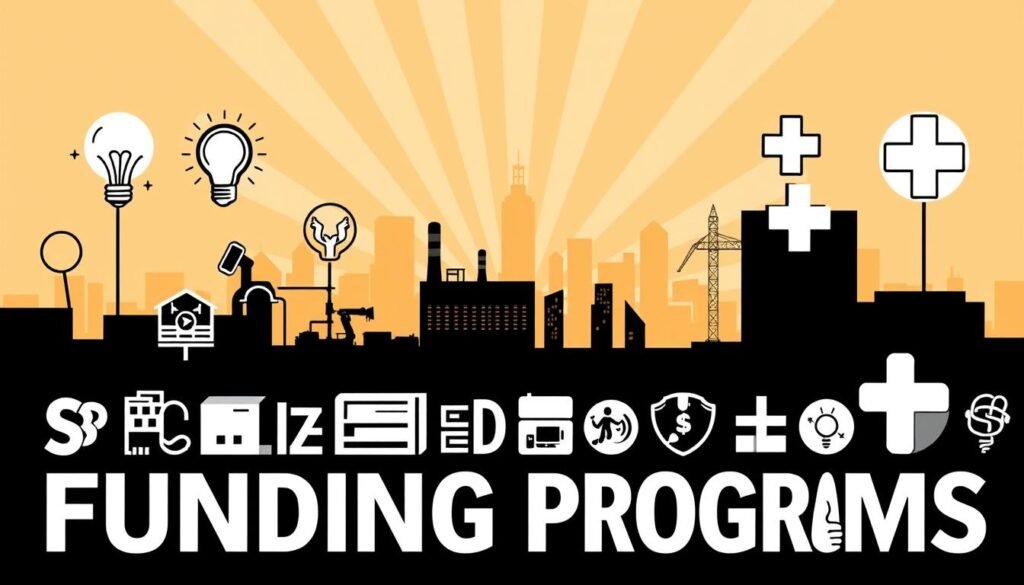Did you know that millions of dollars in funding are available to U.S. businesses and organizations in 2024? Whether you’re a small business owner or part of a larger organization, understanding these programs can be a game-changer.
From federal options managed through SAM.gov and Grants.gov to non-federal sources, there’s a wide range of support available. Active initiatives like the MBDA Business Centers and EDA CARES Act Recovery Assistance are designed to help businesses thrive.
Specialized funding streams, such as those for broadband development and advanced manufacturing, are also worth exploring. Always verify communications from the SBA by checking for @sba.gov email addresses to avoid scams.
Key Takeaways
- Explore diverse funding sources for businesses and organizations in 2024.
- Federal grants are managed through SAM.gov and Grants.gov.
- Active programs include MBDA Business Centers and EDA CARES Act Recovery Assistance.
- Specialized funding is available for broadband and advanced manufacturing.
- Verify SBA communications using @sba.gov email addresses.
Introduction to Grant Opportunities in the United States
The U.S. government offers a variety of programs to support businesses and organizations. These initiatives provide funding opportunities for growth, recovery, and innovation. Whether you’re focused on infrastructure, technology, or trade, there’s a program tailored to your needs.
One notable initiative is the MBDA CARES Act, which allocates $10 million to help minority-owned businesses recover from economic challenges. This program emphasizes development and resilience, ensuring businesses can thrive in competitive markets.

The Economic Development Administration (EDA) plays a key role in COVID-19 recovery. Through infrastructure projects, the EDA provides assistance to communities and businesses impacted by the pandemic. These efforts aim to create jobs and stimulate economic growth.
For those in the technology sector, the National Telecommunications and Information Administration (NTIA) has launched a three-pronged broadband initiative. This includes programs for Infrastructure, Tribal, and Minority Communities, ensuring equitable access to high-speed internet.
Advanced manufacturing is another area of focus. The National Institute of Standards and Technology (NIST) offers grants to support innovation in this field. Active Notices of Funding Opportunity (NOFOs) can be found on Grants.gov, making it easy to apply.
Finally, the International Trade Administration (ITA) supports nonprofits through its Market Development Cooperator Program. This initiative provides export-focused awards, helping organizations expand their reach in global markets.
Federal Grant Programs: A Comprehensive Guide
Federal grant programs are a vital resource for businesses and organizations across the U.S. These funding opportunities are designed to support innovation, growth, and recovery. With thousands of active listings, finding the right program can make a significant difference.
The U.S. government manages these initiatives through platforms like SAM.gov and Grants.gov. These sites provide detailed information on available programs, making it easier to identify suitable options.

Understanding Federal Grants
Federal grants are financial awards provided by the government to support specific projects or initiatives. Unlike loans, they do not need to be repaid. This makes them an attractive option for businesses and organizations seeking funding opportunities.
One example is the NOAA Saltonstall-Kennedy grants, which focus on fisheries and marine projects. With an average award size of $2 million, this program highlights the potential impact of federal support.
Searching for Federal Grants on SAM.gov and Grants.gov
SAM.gov is a key resource for finding federal grants. It hosts over 11,000 active assistance listings, updated daily. To apply, businesses must complete an entity registration on the platform. This step is essential for accessing application materials.
Grants.gov is another valuable tool, processing over 1.2 million monthly searches. With 65+ filter options, users can narrow down results using NAICS codes or CFDA numbers. This advanced search capability ensures you find the most relevant programs.
For disadvantaged businesses, the OSDBU vendor certification process offers additional support. This certification can enhance your eligibility for specific grants and contracts.
Non-Federal Grant Programs: Expanding Your Funding Options
Exploring non-federal funding can open doors for businesses and organizations. While federal programs are widely known, non-federal sources offer unique opportunities for growth and innovation. These programs are often tailored to specific needs, making them a valuable addition to your funding strategy.

Nonprofit and For-Profit Grant Providers
Nonprofit and for-profit providers play a significant role in supporting projects and development. For example, the MBDA Business Centers provide over 15,000 hours of annual technical assistance. This helps businesses navigate challenges and achieve their goals.
The State Trade Expansion Program (STEP) is another success story. Through 2023 Q3, STEP grants generated $1.2 billion in exports. These awards empower organizations to expand their reach in global markets.
Specialized Grant Programs for Minority Businesses
Minority-owned businesses can benefit from specialized programs designed to foster growth. The MBDA’s 40+ nationwide centers offer certification processes and training to enhance eligibility for funding. These initiatives ensure equitable access to resources.
The SBA’s SBIR/STTR programs allocated over $4 billion in 2023. These funds support innovation in technology and development. Additionally, the Made in America Manufacturing Initiative focuses on workforce training, helping communities thrive.
Case studies highlight the impact of these programs. For instance, an MDCP awardee secured $500,000 for export market analysis. Coastal Ocean Program grants also support 120+ marine research projects annually, benefiting communities nationwide.
Specialized Grant Opportunities for Specific Needs
Businesses and organizations can access tailored support through specialized funding programs. These initiatives address unique challenges and provide the resources needed for growth and innovation. Whether you’re focused on infrastructure, technology, or trade, there’s a program designed to meet your needs.

Economic Development and Broadband Grants
The NTIA’s $1.5 billion Broadband Infrastructure Program (2024-2026) is a game-changer for communities lacking high-speed internet. This initiative focuses on connecting minority communities, ensuring equitable access to essential resources. Technical requirements for applications include detailed project plans and community impact assessments.
The EDA has allocated over $3 billion for regional innovation strategies. Their Tech Hubs Program supports projects that drive economic growth and create jobs. Selection criteria emphasize collaboration and matching funding commitments from applicants.
Advanced Manufacturing and Trade Grants
NIST awarded 85 Advanced Manufacturing grants in 2023, totaling $187 million. These programs support innovation in manufacturing processes and technologies. Success stories from the Manufacturing Extension Partnership (MEP) highlight the impact of these resources on small and medium-sized businesses.
The ITA offers export compliance training grants for trade associations. These education initiatives help businesses navigate international trade regulations. NOAA’s Sea Grant Program also funds over 400 coastal projects annually, supporting marine research and community resilience.
These specialized programs provide the tools and funding needed to address specific challenges. By leveraging these opportunities, businesses and organizations can achieve their goals and drive meaningful change.
Conclusion: Navigating Grant Opportunities for Success
Navigating funding options effectively can set your business up for long-term success. Start by completing essential steps like SAM registration and securing a DUNS number. These are critical for accessing federal programs and ensuring your application is processed smoothly.
Be cautious of scams targeting small businesses. Always verify information through official channels like @sba.gov emails. Leverage resources such as OSDBU contacts, SBDC locations, and MBDA regional offices for guidance and support.
Timeline management is key for multi-phase applications. Use the Commerce Department’s procurement forecast analysis to plan strategically. By staying organized and informed, you can maximize your chances of securing the funding your business needs to thrive.
FAQ
What are the best platforms to search for federal funding programs?
SAM.gov and Grants.gov are the primary platforms for finding federal funding programs. They provide comprehensive databases and tools to help businesses and organizations identify suitable options.
Are there specialized funding options for minority-owned businesses?
Yes, there are specialized programs designed to support minority-owned businesses. These initiatives aim to promote equity and provide financial assistance to underrepresented entrepreneurs.
How can I find non-federal funding options for my project?
Non-federal funding can be found through nonprofit organizations, private foundations, and for-profit providers. Researching industry-specific programs and networking with local communities can also help identify these resources.
What types of projects are eligible for economic development funding?
Projects that focus on job creation, infrastructure improvement, and community growth often qualify for economic development funding. Specific eligibility criteria vary by program.
Where can I learn more about advanced manufacturing and trade funding?
Information about advanced manufacturing and trade funding can be found on government websites, industry associations, and specialized grant databases. These resources provide details on application processes and eligibility requirements.
How do I determine if my organization qualifies for federal funding?
Eligibility for federal funding depends on factors like your organization’s mission, location, and project type. Reviewing program guidelines on SAM.gov or Grants.gov is the best way to confirm eligibility.



